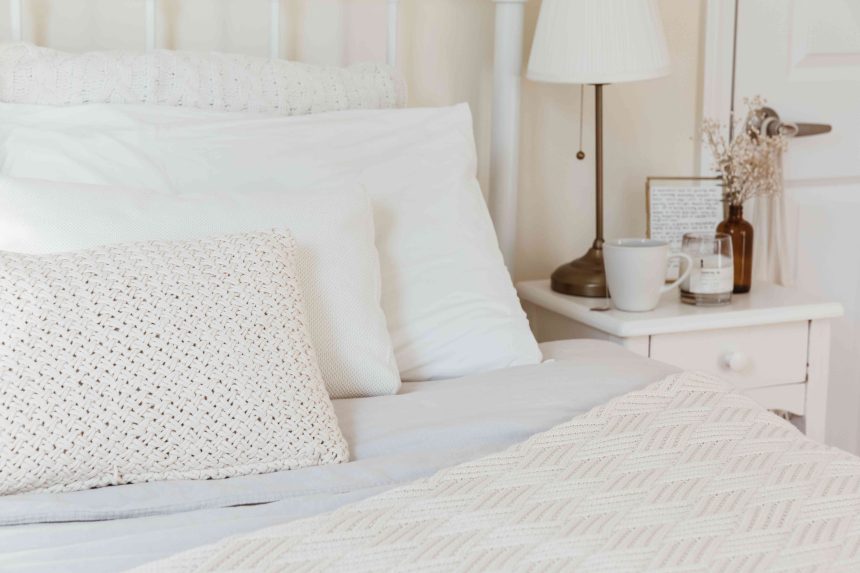The festive season may be over, but chilly weather won’t be going anywhere for a while. If you’ve been spending your nights layered up and shivering—even in your thickest pajamas and socks—your bedroom setup could probably be working harder to keep you warm.
So grab your favorite hot drink and blanket, and get ready to have a more cozy night of sleep. We’ve spoken to the heating experts, who are here to share exactly how to warm up a bedroom in winter, with or without the help of a heater.
Meet the Expert
- Jon Gilbertson is the president and CEO of Chris Heating & Cooling, a family-run HVAC business based in Chicago.
- George Crew is a general contractor with over 30 years of experience, and the owner of Chicago Paint Crew.
- Simon Bernath is the founder and CEO of FurnacePrices.ca, a Canadian HVAC comparison website.
Utilize Cozy Textiles
Having a well-heated cocoon to snuggle up in at the end of the day is essential during the winter season, and by using one of contractor George Crew’s favorite techniques, you can style, decorate, and warm up your bed at the same time.
“Layering textiles is one of the simplest ways to warm up a bedroom,” Crew sats. “Adding a thick area rug will feel great on your feet in the morning and help to insulate the room overall. Cover the bed itself with cozy blankets and throws, and create an irresistibly warm bed using flannel sheets, a wool blanket, or plush comforter to help retain body heat.”
Want more home reno project tips and inspiration? Sign up for our free daily newsletter for the latest how-tos, reno guides, and more!
Use Heating Pads and Hot Water Bottles
T-Pool/STOCK4B/Stock4B/Getty Images
Nothing is more inviting than a warm and comfortable bed in the wintertime, and you can make your sleep space feel even cozier by amplifying your body heat. Textiles like flannel sheets work well, but personal heat sources can take winter warmth to the next level.
“A hot water bottle tucked between you and your bed before you get between the sheets will create a walled off area of warmth that will stay with you for many hours,” Crew says. “Heating pads and electric blankets can give also give you targeted warmth on those very cold nights.”
Hang Thermal Curtains
“If you haven’t yet, you should hang floor-to-ceiling thermal curtains in your bedroom to create a barrier between the cold window and the room and prevent heat loss,” Chris Heat & Cooling’s president Jon Gilbertson says.
Thermal curtains can be highly effective when paired with central heating or space heaters, but shouldn’t be used in bedrooms where a radiator is placed directly under a window—the heat will end up trapped between the curtains and the window, keeping your radiator from warming the rest of the room up.
Place Space Heaters Wisely
Space heaters can be the most effective way to heat up a bedroom. So, if you have one or are able to invest in one, it’s important to make sure you’ve placed your heater in an area that allows it to do its job as well as possible.
“The general rule is to place a space heater in the center of the room to ensure proper airflow and even heat distribution throughout the room,” Gilbertson says. “But, if your bedroom is poorly insulated and you notice any cold drafts near walls or electrical outlets, it’s best to place the heater nearby to counteract any incoming cold air.”
Set Ceiling Fan Direction
The Spruce / Sarah Lee
It might seem counterintuitive to turn your ceiling fan to help warm up a bedroom, but these fixtures don’t actually create a cool temperature—they simply circulate the air in the room, whether it’s warm or cold. HVAC expert Simon Benrath says switching the direction of your fan when the weather gets colder can work wonders in spreading heat evenly throughout the space.
“Setting the ceiling fan in reverse mode can help gently circulate air in the room and keep the heat from just accumulating at the top of the room, making it feel warmer,” he says.
Use a Humidifier
“Check the humidity in your bedroom, and increase it if needed,” Gilbertson says. “A room with dry air will feel about 3 to 5 degrees Fahrenheit colder than a room with 45-50% humidity, even with thermostats set at the same temperature.”
According to Bernath, the perfect humidity level for a bedroom is between 30 to 45 percent, which can help with both warmth and overall comfort in the chillier months.
“A humidifier will help you maintain the ideal humidity level, which can make the room feel more comfortable as well, especially as the air can sometimes be drier in winter,” he says.
Insulate the Room
“Think less about how to add heat and more about how to keep it in,” Gilbertson says. “A well-insulated bedroom doesn’t need much heating and often doesn’t even require a space heater.”
To prevent drafty doors and windows, our experts recommend winterizing your windows, installing weatherstripping or plastic film, and making use of a door stopper or draft excluder.
As a no-cost alternative, you can also roll up old towels and blankets to blankets to block any cracks along your bedroom’s windowsill and under the door.
Open (or Close) the Door
After implementing all of these tips and techniques, you might be tempted to keep the bedroom door closed at night to make sure heat stays inside your bedroom. But, according to Benrath, an open door may actually be your best bet—depending on your room’s heat source.
“Keep the door to the room closed if you’re using a space heater and/or humidifier to keep the warm air in,” he says. “However, you’ll want to keep the door open at night instead if you’re relying on central heating,”







